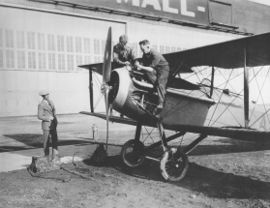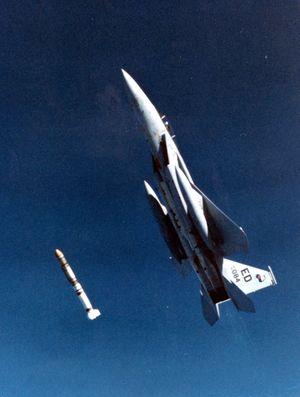PlaneSpottingWorld welcomes all new members! Please gives your ideas at the Terminal.
Vought

Vought is the name of several related aerospace firms. These have included, in the past, Lewis and Vought Corporation, Chance Vought, Vought Sikorsky, LTV Aerospace (part of Ling-Temco-Vought), Vought Aircraft Companies, and the current Vought Aircraft Industries. The first incarnation of Vought was established by Chance M. Vought and Birdseye Lewis in 1917. In 1928, it was acquired by United Aircraft Corporation, the first of many reorganizations and buyouts. Vought produced thousands of planes during World War II, including the iconic F4U Corsair. Ling-Temco-Vought bought Vought in 1961, and while designing and producing a variety of planes and missiles throughout the Cold War, suffered numerous reorganizations. Vought was sold from LTV and owned in various degrees by the Carlyle Group and Northrop Grumman in the early 1990s. It was then fully bought by Carlyle, renamed Vought Aircraft Industries, and continues aerospace work today.
Contents
History
The Chance Vought years 1917-1928
The Lewis and Vought Corporation began in 1917 and was soon succeeded by the Chance Vought Corporation in 1922 when Birdseye Lewis retired. A former chief engineer of the Wright Company, Chance Vought began the company to take advantage of the growing field of military and civilian aviation after World War I. Operations began in Astoria, New York and in 1919 were moved to Long Island City, New York.
Vought died from septicemia in 1930, but in that short time period succeeded in producing a variety of fighters, trainers, flying boats, and surveillance aircraft for the US Navy and the US Army Air Service. Vought made history in 1922 when their VE-7 "Bluebird" trainer made the first takeoff from the decks of the USS Langley, the first American aircraft carrier. Following this success came the VE-11 naval fighter and the O2U Corsair, the first of the Corsair aircraft.
In 1928, the company was acquired by United Aircraft and Transport Corporation, but stayed its own separate division among the likes of Pratt and Whitney and Boeing.
1930s-1960
Despite the Great Depression, Vought continued to design and manufacture aircraft at a growing pace. Soon after Chance Vought's death in 1930, the company moved its operations to East Hartford, Connecticut. Under the Air Mail Act of 1934, United Aircraft and Transportation Corp. was forced by law to divide its businesses, resulting in Boeing Aircraft, United Airlines, and the United Aircraft Corp, of which Vought was a part. In 1939 United Aircraft moved Vought to Stratford, Connecticut where their Sikorsky division was located and renamed the entire division Vought-Sikorsky Aircraft.
Chief Engineer Rex Beisel began in 1938 to develop the XF4U, recognized by its distinctly inverted gull wings. After a maiden flight in 1940, thousands of F4U Corsairs were produced for the Navy and Marines in World War II. By the end of its production in 1952, Vought, Goodyear, and Brewster had all produced the aircraft at one point or another. Vought was reestablished as a separate division in United Aircraft in 1942.
In postwar 1949, Vought moved operations to Dallas, Texas where the former North American "B" plant was located. Initiated by the Navy, who feared having their two main aircraft manufacturers located on the East Coast posed an unnecessary risk, Vought moved 27 million pounds of equipment and 1300 employees in 14 months, a record breaking industrial move at the time.
In 1954, the company fully separated from United Aircraft and became the independent Chance Vought Aircraft Inc.
Vought began manufacture of its F-8 Crusader for the US Navy in 1957, one of the first Navy fighters capable of supersonic flight and the Navy's last all-gun fighter. The same basic design was later heavily revised and shortened to produce Vought's A-7 Corsair II, a carrier-borne close air support and attack plane in 1965, an aircraft which would become heavily engaged in a variety of close support and strike missions during the Vietnam War, beginning in 1967. The A-7 has also participated in the US invasion of Grenada in 1983; a punitive raid on Syrian missile sites, in 1983; reprisal raids against Libya during OPERATION: EL DORADO CANYON, in 1986; strikes against Iranian coastal platforms and naval forces during OPERATION PRAYING MANTIS, in 1988; support of the 1989 invasion of Panama; and throughout operations during Desert Storm in 1991. The A-7A and A-7E served with the US Navy while the A-7D was purchased by the US Air Force and Air National Guard. Two-seat models known as the TA-7C/E served with the US Navy while the US Air Force purchased the TA-7K. The A-7 still serves in limited numbers with three foreign air forces, including Greece (A-7H/TA-7H), Portugal (A-7P/TA-7P) and Thailand (ex-USN A-7E/TA-7E).
LTV acquisition 1960-1990
- Further information: Ling-Temco-Vought
Vought was bought by James Ling in 1962, forming the new conglomerate Ling-Temco-Vought (LTV). Yet despite the buyout, Vought Aeronautics and Vought Missiles and Space continued to develop and produce for the Air Force and Navy under the umbrella of LTV Aerospace.
By the early 1980s, LTV was struggling, and Vought suffered heavy layoffs. The first of two decades of reorganizations began in 1972 with the creation of Vought Systems by the merging of the Vought Missiles and Space and Aeronautics divisions.
All of LTV Aerospace was renamed the Vought Corporation in 1976, but by 1983 the Vought company was again split along aeronautic and missile lines under LTV Aerospace and Defense.
1992 proved the end of Vought's relationship with LTV. In mid-year the aircraft division was purchased by Northrop and the Carlyle Group, each owning roughly 50% of the company. Additionally, the missile division was entirely sold to the Loral Corporation. That original legacy Vought missiles division in Texas is currently a vital part of Lockheed Martin Missiles and Fire Control.
1990s to today
Northrop Grumman, the successor to Northrop, bought out the Carlyle Group's share of Vought for $130 million in 1994. The Carlyle Group then purchased the entire company from Northrop Grumman in 2000 and established Vought Aircraft Industries, Inc., the current incarnation. It is now primarily an aerostructures subcontractor. Vought is heavily involved in the Boeing 747, Boeing 787 aircraft as well as supplying parts for the F-22 Raptor and F-35 Lightning II and the V-22 Osprey. In July 2003, the Aerostructures Corp., owned by the Carlyle Group and based in Nashville, Tennessee, merged with Vought.[1] Vought's Nashville site supplies wing components for Airbus A319, A320, A330, and A340.
Notable Vought systems
Aircraft
- O2U Corsair (1926)
- OS2U Kingfisher (1938)
- SB2U Vindicator (1936)
- F4U Corsair (1940)
- TBU Sea Wolf (1941); Vought-designed; Production was by Consolidated as the TBY.
- F6U Pirate (1946)
- XF5U Flying Flapjack (1947)
- F7U Cutlass (1948)
- F-8 Crusader (1955), formerly F8U Crusader.
- F8U-3 Crusader III (1958)
- LTV XC-142 (1964)
- A-7 Corsair II (1965)
Missiles
- Boeing C-17 Globemaster III (ailerons, elevators, and rudders)
- Bell/Boeing V-22 Osprey (empennage, ramp/ramp door)
- Boeing 747 (fuselage panels, tail section)
- Boeing 767 (center wingbox, horizontal stabilizer)
- Boeing 777 (spoilers, flaps)
- Boeing 787 (fuselage barrels—Sections 47 and 48)
- Lockheed C-5M Super Galaxy (flight control surfaces)
- Lockheed C-130 Hercules (empennage)
- Lockheed/Boeing F-22 Raptor (stabilator)
- Northrop B-2 Spirit
- Sikorsky UH-60 Blackhawk/SH-60 Seahawk
- Airbus A319 A320 (upper wing panel assemblies)
- Airbus A330 A340 (mid- and outer-leading edge assemblies, mid-rear spars, center spar assembly, flaps, fairings and upper panel assemblies )
- Airbus A340-500/-600 (mid- and outer-leading edge assemblies, mid-rear spars, center spar assembly, upper panels and stringers)
Joint ventures
- Global Aeronautica, LLC (50%, with Alenia) — for the Boeing 787
References
- Official site
- Vought Aircraft Industries website's "Heritage" section, with history, photos, and original line drawings of Vought aircraft
- US Centennial of Flight Commission
External links
Template:Vought aircraft Template:Aviationlists
be:Воўт cs:Vought fr:Vought ja:ヴォート・エアクラフト・インダストリーズ pl:Chance Vought
| This article is licensed under the GNU Free Documentation License. It uses material from the Wikipedia article "Vought". |


